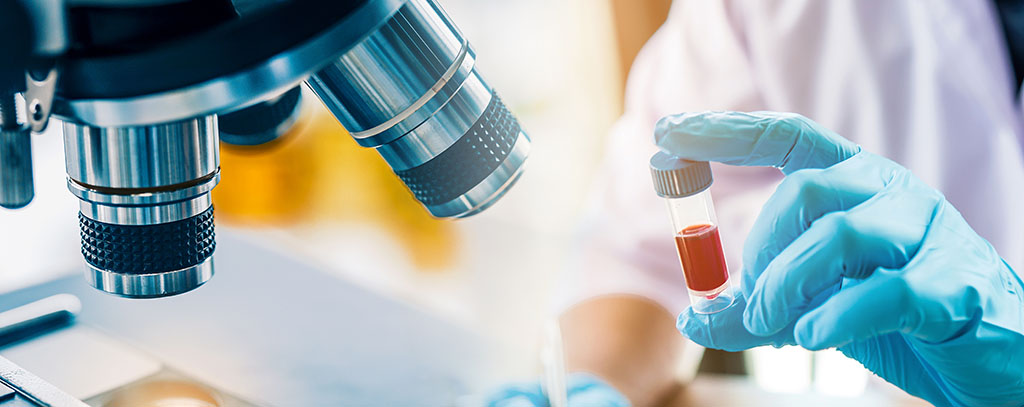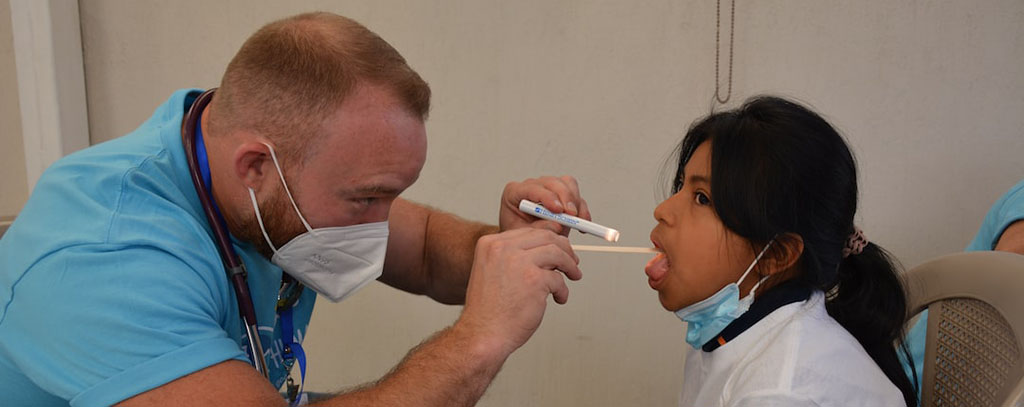


What Does a 5 Panel Drug Test Test For?
February 11, 2023


What Does a 10 Panel Drug Test Test For? Get the Facts Here!
February 13, 2023Strep throat is a common bacterial infection that affects millions of people each year. But how long does strep throat last? This blog post will answer your questions and provide helpful information on symptoms, diagnosis, treatment, prevention and potential complications associated with this condition. Understanding the facts about strep throat can help you make informed decisions regarding your health care needs - so it's important to know what to look for when assessing whether or not you have the infection as well as understanding how long does strep throat last in order to manage its effects accordingly.
Symptoms of Strep Throat
Strep throat is a contagious bacterial infection of the throat and tonsils caused by Streptococcus bacteria. It can cause severe soreness, redness, and swelling in the back of the throat. Common symptoms include:
Sore Throat: The most common symptom of strep throat is a sudden, severe sore throat that makes it difficult to swallow. The pain may be accompanied by swollen lymph nodes in the neck and fever.
Fever: often causes an elevated temperature or fever higher than 101°F (38°C). Other signs of infection such as chills or sweats may also occur with a fever.
Swollen Lymph Nodes: Swollen lymph nodes are usually present when someone has strep throat. These glands are located on either side of your neck just below your ears and become tender when infected with strep bacteria.
White Patches on Tonsils: White patches on one’s tonsils may appear due to inflammation from an infection like strep throat which can be seen using a flashlight while looking into the mouth mirror at an angle.
Headache and body aches are other common symptoms associated with strep infections. If these persist for more than two days without any relief from over-the-counter medications such as ibuprofen or acetaminophen, it could indicate that you have contracted this illness.
Knowing the symptoms of strep throat can help you determine if it's necessary to seek medical attention for diagnosis and treatment.
Diagnosis of Strep Throat
It can cause symptoms such as sore throat, fever, swollen lymph nodes in the neck and difficulty swallowing. Diagnosing strep throat requires a physical examination and/or a throat swab strep test kit. A doctor will typically begin with a physical examination of the patient’s mouth and throat to look for signs of inflammation or redness. The doctor may also feel for any enlarged lymph nodes in the neck area that could indicate an infection. If there are signs of an infection present, they may order a rapid antigen detection test (RADT) or perform a throat swab culture to confirm if it is indeed strep throat.
The RADT is done onsite at most medical offices using either saliva or mucus from inside the nose or back of the mouth which is then tested for antigens associated with strep bacteria within minutes. A positive result indicates that it's likely strep while negative results require further testing through cultures taken from samples collected via swabs from both sides of your tonsils and sometimes other areas like your adenoids too, depending on what your doctor suspects might be causing your symptoms.
The culture sample will then often be sent off to a lab where technicians will examine it under microscopes looking for evidence of live bacteria colonies growing on petri dishes containing agar gel media. This process usually takes about 48 hours before results are available, but can take up to several days depending on the lab's workload. Patience may be required when waiting for these results.
Once confirmed, treatment options can include antibiotics prescribed by your physician as well as over-the-counter medications such as ibuprofen or acetaminophen to help reduce pain and fever associated with strep infections. However, it is important to consult with your healthcare provider before taking any medication, especially if you have allergies or pre-existing conditions that could interact negatively with them.
A proper diagnosis of strep throat is essential to ensure the correct treatment is provided. The next heading will discuss various treatments available for this condition.
Treatment for Strep Throat
It can cause symptoms such as sore throat, fever, and swollen lymph nodes in the neck. Treatment for strep throat usually involves antibiotics to help clear up the infection quickly and prevent complications.
Antibiotics are typically prescribed to treat strep throat. Commonly used antibiotics include penicillin, amoxicillin, or cephalosporins. These medications work by killing off the bacteria that cause strep throat. Most people will start feeling better within 24-48 hours of starting an antibiotic treatment plan; however it may take several days before all symptoms have cleared up completely.
Over-the-counter (OTC) medications can also be used to help relieve some of the symptoms associated with strep throat such as pain and inflammation in the throat area. OTC pain relievers like ibuprofen or acetaminophen can reduce discomfort from soreness and fever while lozenges or gargling salt water may help soothe a sore throat temporarily until antibiotics kick in fully. Decongestants may also be helpful if you’re having difficulty breathing due to nasal congestion caused by your infection, but should not be taken if you have high blood pressure or heart disease without consulting your doctor first since they could worsen these conditions further when taken improperly.
It is important to finish taking any prescribed course of antibiotics even after feeling better, as this helps ensure that all traces of bacteria causing your illness are eliminated completely and reduces the chances of relapse significantly. If left untreated, complications from strep throat such as rheumatic fever or kidney inflammation can occur, so it is best to seek medical attention right away if you think you might have been exposed to this type of infection.
Proper treatment of strep throat can help reduce the severity and duration of symptoms. To prevent future occurrences, it is important to understand how to avoid getting infected with this bacteria in the first place.
Prevention of Strep Throat
Fortunately, there are several ways to prevent strep throat from occurring in the first place.
Good Hygiene: The best way to prevent strep throat is by practicing good hygiene habits such as washing your hands regularly with soap and water for at least 20 seconds or using an alcohol-based hand sanitizer if soap and water are not available. It’s also important to avoid touching your face or sharing items like utensils or cups with someone who has strep throat.
Vaccination: Vaccines can help protect against certain types of bacteria that cause strep throat infections. Talk to your doctor about which vaccines may be right for you and your family members based on age and health history.
Avoid Crowded Areas: Strep throat is highly contagious so it’s important to limit contact with people who have the infection as much as possible. Avoid crowded areas such as schools, daycare centers, nursing homes, hospitals, etc., where germs spread easily from person-to-person contact.
Keep Surfaces Clean: Make sure all surfaces in the home are cleaned regularly with disinfectant wipes or sprays since these products kill most germs on hard surfaces like countertops and doorknobs. Additionally, make sure everyone in the household washes their hands often throughout the day especially after coming into contact with any shared objects like phones or remote controls that could carry germs from one person to another quickly.
Staying hydrated is important for reducing irritation caused by dryness when coughing or sneezing due to a sore throat associated with strep infection. This also reduces the chances of spreading germs through droplets in saliva released during those activities. Drinking plenty of fluids helps keep mucous membranes moist, which can help reduce these symptoms.
By taking preventative measures such as good hygiene, avoiding close contact with those who have strep throat, and getting vaccinated when available, the risk of developing strep throat can be greatly reduced. Moving on to the next heading, let's take a look at some of the potential complications associated with strep throat.
Complications of Strep Throat
Strep throat can cause serious complications if left untreated or improperly treated. The most common complication is rheumatic fever, which is an inflammatory disease that affects the heart and joints. It can lead to permanent damage of the heart valves and other organs in severe cases. Other possible complications include ear infections, sinusitis, meningitis, abscesses in the tonsils or throat, kidney inflammation (glomerulonephritis), scarlet fever, and pneumonia.
If you experience any of these symptoms after a strep infection it’s important to seek medical attention right away: high fever for more than three days; rash on body or face; chest pain; difficulty breathing; swollen glands around neck area; joint pain or swelling; skin lesions with pus-filled bumps near joints.
Rheumatic fever usually occurs two to four weeks after a strep infection but may take up to eight weeks before symptoms appear. Symptoms may include joint pain and swelling as well as a red rash on the trunk and limbs that doesn't fade when pressure is applied (known as "slapped cheek syndrome"). If not treated promptly it can lead to long-term problems such as chronic arthritis and valve damage in the heart leading to congestive heart failure later in life.
Kidney inflammation (glomerulonephritis) is another potential complication of strep throat caused by bacteria entering into the bloodstream from an untreated sore throat infection resulting in inflammation of small blood vessels within your kidneys causing them to leak protein into your urine along with red blood cells which will make your urine look cloudy or dark colored due to presence of red blood cells. Symptoms include abdominal pain, vomiting, decreased urination frequency, fatigue, and nausea. This condition needs immediate medical attention because if left untreated it could result in kidney failure over time.
Scarlet Fever is another rare but potentially dangerous complication associated with strep throat caused by toxin produced by certain strains of group A Streptococcus bacteria. It causes a reddish-pink rash all over the body, accompanied by a sore throat, headache and chills. Prompt treatment is necessary to avoid further health issues such as rheumatic fever and glomerulonephritis. Therefore, it is important for parents and caregivers alike to be aware of this condition and seek medical help immediately if they notice any signs related to Scarlet Fever.
Strep throat can cause serious complications if left untreated, so it is important to be aware of the potential risks. Now let's explore how long strep throat usually lasts.
How Long Does Strep Throat Last
It is highly contagious and can spread quickly through contact with an infected person or object. Symptoms usually begin to appear within two to five days after exposure, but may take up to 10 days in some cases.
The most common symptom of strep throat is a sore throat that lasts for more than 48 hours without improvement. Other symptoms include fever, swollen lymph nodes in the neck, white patches on the back of the throat, headache, nausea, abdominal pain and loss of appetite. If left untreated, complications such as rheumatic fever or kidney inflammation can occur.
Diagnosis for strep throat typically involves a physical examination followed by either a rapid antigen test or culture swab test from your doctor’s office or lab results from a sample taken at home using an at-home testing kit purchased from drug stores or online retailers. The rapid antigen test takes only minutes while the culture swab test takes one to two days for results to be available.
Treatment for strep throat includes antibiotics prescribed by your doctor which should be taken exactly as directed until finished, even if you start feeling better before finishing all doses prescribed. This helps prevent any further complications due to an incomplete treatment course. Over-the-counter medications such as ibuprofen (Advil) and acetaminophen (Tylenol) may also help reduce discomfort associated with strep symptoms like fever and body aches. Additionally, drinking plenty of fluids will help keep you hydrated throughout the recovery process, which usually takes three to seven days depending on how early it was treated with antibiotics after onset of symptoms appeared.
FAQs in Relation to How Long Does Strep Throat Last
How long does a strep throat take to heal?
It typically takes between 3-7 days for symptoms to resolve with proper treatment, such as antibiotics and rest. However, it can take up to 10 days or longer for some people to completely recover from strep throat. To reduce the risk of complications, it's important to finish all prescribed medications even if you start feeling better after a few days. Additionally, drinking plenty of fluids and eating soft foods can help speed up recovery time.
How long is a strep throat contagious?
It is spread through direct contact with saliva or nasal secretions of an infected person, usually through coughing and sneezing. The incubation period for strep throat can range from 1 to 5 days before symptoms begin to appear. After the onset of symptoms, a person with strep throat will remain contagious for up to 2 weeks if not treated with antibiotics. To prevent the spread of infection, it is important to practice good hygiene such as washing hands regularly and avoiding close contact with those who are sick.
Will strep throat go away on Own?
It can be treated with antibiotics, and in most cases, symptoms will go away within 1 to 2 weeks of starting treatment. However, if the infection is not treated promptly or correctly, it may take longer for the symptoms to resolve completely. Additionally, some people may experience relapses of strep throat even after successful treatment. Therefore, it is important to seek medical advice and follow the prescribed course of treatment for best results.
How can I get rid of strep throat fast?
To get rid of it quickly, you should start treatment as soon as possible with antibiotics prescribed by your doctor. Additionally, rest and drink plenty of fluids to help speed up recovery. Gargling salt water can also reduce pain and inflammation in the throat. Avoiding contact with others who are sick will help prevent further spread of the infection. Finally, if symptoms persist for more than a few days or worsen, seek medical attention immediately.
Conclusion
Strep throat is a common bacterial infection that can be treated with antibiotics. It usually lasts between 7-10 days but may last longer if not properly treated. Prevention is key in avoiding the spread of strep throat and it's important to remember that how long does strep throat last depends on many factors such as age, severity of symptoms, and proper treatment. If you or someone you know has been experiencing any of the symptoms associated with strep throat, it's best to seek medical attention right away for an accurate diagnosis and effective treatment plan.
If you are looking for ways to test and diagnose strep throat, then look no further than Halux Diagnostic. Our strep throat testing supplies can help provide fast and accurate results so that treatment can begin quickly. With our top-of-the-line diagnostic tools, you'll be able to determine how long the strep throat will last with just a few simple steps. Don't wait until it's too late - get the answers you need today with Halux Diagnostic!





